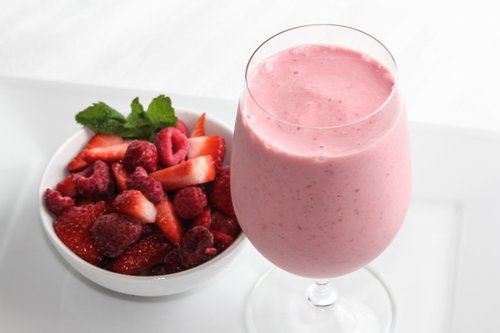5 Things To Love About Milk
June 13, 2019
By Ann Thelen
June is National Dairy Month and it’s a perfect time to celebrate one of our favorite dairy products – milk! Whether putting it on a favorite cereal, chugging ice-cold chocolate milk after a workout or enjoying a glass with dinner (or in your favorite latte!), milk has something for everyone. Milk is an essential refrigerator staple, and it’s a simple and delicious way to get essential nutrients your body needs.
Please note, by clicking the links you will be leaving a partially funded checkoff site.
Alyson Fendrick, registered dietitian and marketing and communications manager for Midwest Dairy, shares that DairyGood.org is a terrific resource to learn more about milk's benefits. DairyGood was created by and is managed by the Innovation Center for U.S. Dairy, which represents dairy farmers across the country.

“DairyGood focus on three key areas – healthy people, healthy communities and a healthy planet, which are things most Iowans are also passionate about in their lives,” she explains. “Through the use of innovation and safe technology, the dairy industry delivers exceptional animal care, sustainable nutrition and a great product.”
Iowa is the 12th largest milk-producing state in the U.S., producing approximately 562 million gallons of milk on approximately 1,200 dairy farms. Dairy has been nourishing Iowa’s communities for a long time and many of the state’s dairy farms are family-owned.
When it comes to milk – there is a lot celebrate! See why by exploring the following “5 Things to Love About Milk” list, which includes information from DairyGood.org.
5 Things to Love About Milk
1. Milk is one of the freshest items in the grocery store
Fresh and wholesome milk makes its way from the farm to your local dairy cases on an average of 48 hours! During that brief time, it goes through several steps to ensure freshness and purity. The high-quality milk begins with farmers who are diligent in providing their dairy cows with exceptional care through nutritious food, fresh and clean water, comfortable bedding, sanitary living conditions and climate-controlled temperatures. The healthier and happier cows are, the more milk they will produce. When it’s the farmer’s livelihood, they work hard to do the best they can in all these areas.
Once the milk is transported from the farm – in insulated milk truck to a processing plant – it goes through several steps. They include standardization – skimming milk from the cream; pasteurization – quickly heating the milk to remove any unwanted bacteria that may have been in unpasteurized milk; and homogenization – breaking the fat in milk into small particles so it doesn’t separate and rise to the top.
Fun Fact: Milk fat percentages (specifically 1% and 2%) refer to the amount of fat in the milk by weight. Whole milk, which is the closest to what it would be coming from a cow, is about 3.5% fat; fat-free or skim milk contains very little fat (less than 0.2%).
2. Milk is a high-quality complete protein
All dairy milk – whether it is fat-free, whole or flavored – provides nine essential nutrients. Milk is a “complete” protein, which provides the full mix of essential amino acids. Protein is important for many reasons – it helps to build lean muscle and keep bones strong.
According to DairyGood, many experts recommend getting 25 to 30 grams of protein at each meal. The timing of protein is vital as well, especially at breakfast – a meal that’s often heavier in carbs and lighter on protein. Incorporating protein at breakfast helps you feel full and satisfied so you won’t feel hungry by mid-morning. By pairing your morning meal with a glass of milk, it can help you reach a recommended amount of protein before noon.
Fun Fact: No matter which variety of milk you enjoy, all cow’s milk contains at least 8 grams of protein per 8-ounce glass.
3. Milk is high in vitamins and the No. 1 source of calcium in American’s diets
In addition to naturally occurring, high-quality protein, milk contains other nutrients including B vitamins for energy, vitamin A to help maintain a healthy immune system. One 8-ounce glass of milk provides 25% of the calcium a person needs each day, which helps to build healthy bones and teeth.
In fact, milk is the top food source for calcium, potassium and vitamin D, three of the four “nutrients of public health concern” – nutrients that many Americans, including children, are most lacking in their diets.
Fun Fact: Adding Vitamin D to milk goes back to the 20th Century, when rickets, a childhood bone disorder was caused by not getting enough vitamin D. In fact, around 80% of children in Boston had rickets at that point in history. In 1922, Dr. E. V. McCollum discovered that vitamin D could prevent rickets. Because vitamin D is not prevalent in many foods, fortifying milk with additional vitamin D was a natural solution, since it also contained key minerals for bone development. Because of this, rickets is now a rare disease in the U.S.
4. Milk is the key ingredient in many dairy foods and good for you
Healthy dietary patterns that include dairy foods like milk, cheese and yogurt have even been shown to help reduce risk of diseases like type 2 diabetes, heart disease and high blood pressure.
Cheese. Ice Cream. Yogurt. Sour Cream. These are just a few of the foods where milk is a primary ingredient. From pizza toppings to casseroles to cottage cheese, milk is a foundational component of many delicious foods.
Fun Fact: In the U.S., each person consumes about 34 pounds of cheese in a year! With a population of roughly 327.2 million people that equals 11.1 billion pounds of cheese. Every. Single. Year. Now, that takes a lot of milk!
5. Milk is the upcycling of nutrients
Cows are the ultimate recyclers. Gregory D. Miller, PhD, FACN, who is the chief science officer at the National Dairy Council explains, “Dairy cows and other ruminant animals have unique stomachs that allow them to eat parts of plants and foods that humans can’t eat such as almond hulls, wheat straw, etc. They then can unlock nutrition from these human inedible parts of food and turn them into nutrient-rich milk that can help nourish people. It’s a simple way to turn things that we can’t eat into a nutritious food that we can!”
Let’s all raise a glass of ice-cold milk and toast to the nutritional benefits of milk and Iowa’s dairy farmers! While you’re at it, try these milk-inspired recipes to beat the heat this summer and pump up hydration.

Recipe from Midwest Dairy
4 servings
Ingredients
- 1 cup low-fat vanilla yogurt
- 1 cup frozen raspberries unsweetened
- 1 cup frozen strawberries unsweetened
- 3/4 cup low-fat milk
- 1 cup ice (about 12 cubes)
Directions: Blend all ingredients in a blender until smooth. Serve immediately and enjoy.
Other refreshing dairy recipes from Midwest Dairy and DairyGood: